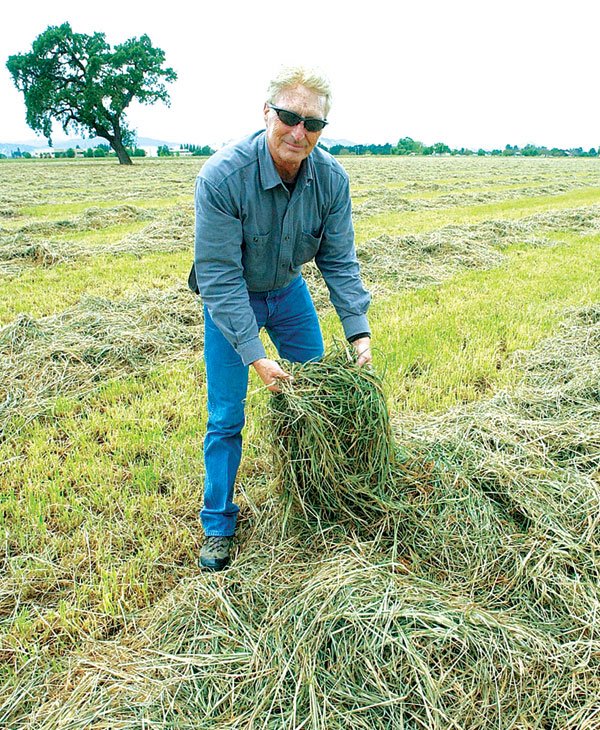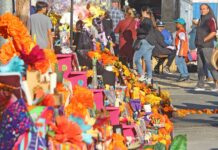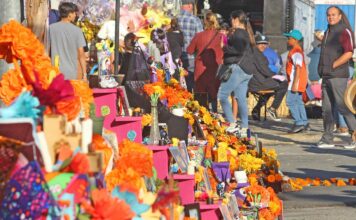Gilroy
– Kip Brundage, president of G
&
amp;K Farms, subscribes to five different weather channels with
live Doppler radar. They are on 24-hours a day in his office. He
knows the weather 90 days out, and can tell you what to expect on a
farm in Watsonville next Sunday at 3pm.
Gilroy – Kip Brundage, president of G&K Farms, subscribes to five different weather channels with live Doppler radar. They are on 24-hours a day in his office. He knows the weather 90 days out, and can tell you what to expect on a farm in Watsonville next Sunday at 3pm.
“A farmer only wants rain when he wants it,” he explained.
And nowadays, rain is a lot more than a nuisance to local farmers.
Last year, the state was in a hay deficit and needed to purchase the crop from as far away as Utah and Idaho. At the start of this season the state was simply looking to break even with hay production, Brundage said. But with heavy rainfall, one rotation of the crop was lost and with Thursday’s rain – another of his six crop rotations have been damaged.
“I’ve lost one third of my crop for the year,” Brundage said.
And it may get worse as rain is expected Sunday and Monday
Farmers don’t factor rain into their schedules after April 15, he explained. Consumers are going to pay for it for months to come as the cost of feed increases.
Ordinarily, one bale of hay costs between $10 and 12. During the expected shortage, consumers will see prices rise an additional $2.
Two dollars may not sound like much, but do the math. Assume each cow uses one bale of hay per week, multiply $2 by the number of livestock on the ranch, and the figure adds up.
According to Brundage, the problem will arise when the cost increases and feed becomes scarce, or non-existent.
“The average consumer doesn’t feel it until they walk into a store and see the price and say, ‘What happened?'” Brundage said. “Like what happened with tomatoes last year.”
But hay and livestock farmers have company in their misery.
Thirty seconds after Pete Aiello got off the phone with a record setting strawberry sale, he was informed by Uesugi Farm’s foreman that the rain was making conditions too poor for workers to harvest.
“It’s really throwing a wrench in our gear,” said Aiello, the farm’s owner and sales manager. “We usually pick through any kind of condition, rain or shine, and this morning we were actually out in the fields, but it eventually got so bad …”
Aiello was forced to cancel his record setting order of 3,000 flats of strawberries moments later.
“It’s frustrating,” he sighed.
Cardboard boxes become saturated from the water, rendering the container useless. Mud splashes onto the fruit and consumers don’t want to buy it, he explained.
“Any pulpy fruit like a strawberry is very susceptible to mold or decay,” Aiello said. “It’s fine when it’s on the vine,” but once it’s picked and exposed to moisture – it becomes a race between selling and consuming the fruit before it begins to turn.
The window once a strawberry has gotten wet is between 24 and 48 hours. After that: “It’s really bad news,” Aiello said. The fruit you picked one day before looks completely different.
The strawberries sold at Uesugi Farm have a high sugar content and are picked close to their pique ripeness – perfect for eating right away, but problematic for storing long-term.
“We hope they get consumed in a timely manner,” he said. Possible ideas for fruit that is turning: Make jams, strawberry sauce, strawberry daiquiris, or smoothies. “There’s always something you can do with it,” he assured.
Typical strawberry season extends from the end of March into early July. Ideal climate would be, cool, temperatures in the 70’s, and no rain, Aiello said.
“In other words, this is not ideal strawberry weather.”













